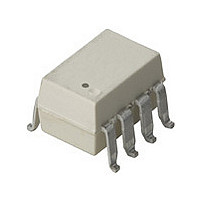HCPL-7840#360 Avago Technologies US Inc., HCPL-7840#360 Datasheet - Page 16

HCPL-7840#360
Manufacturer Part Number
HCPL-7840#360
Description
OPTOCOUPLER AMP 100KHZ VDE 8-SMD
Manufacturer
Avago Technologies US Inc.
Datasheet
1.HCPL-7840-000E.pdf
(19 pages)
Specifications of HCPL-7840#360
Amplifier Type
Isolation
Number Of Circuits
1
Output Type
Differential
-3db Bandwidth
100kHz
Current - Input Bias
500nA
Voltage - Input Offset
300µV
Current - Supply
10.9mA
Current - Output / Channel
15.5mA
Voltage - Supply, Single/dual (±)
4.5 V ~ 5.5 V
Operating Temperature
-40°C ~ 85°C
Mounting Type
Surface Mount
Package / Case
8-SMD Gull Wing
Operating Supply Voltage (typ)
5V
Lead Free Status / RoHS Status
Contains lead / RoHS non-compliant
Slew Rate
-
Gain Bandwidth Product
-
Lead Free Status / RoHS Status
Not Compliant, Contains lead / RoHS non-compliant
Available stocks
Company
Part Number
Manufacturer
Quantity
Price
Current Sensing Resistors
The current sensing resistor should have low resistance
(to minimize power dissipation), low inductance (to
minimize di/dt induced voltage spikes which could
adversely affect operation), and reasonable tolerance
(to maintain overall circuit accuracy). Choosing a
particular value for the resistor is usually a compro-
mise between minimizing power dissipation and
maximizing accu-racy. Smaller sense resistance de-
creases power dissipation, while larger sense resistance
can improve circuit accuracy by utilizing the full input
range of the HCPL -7840.
The first step in selecting a sense resistor is determining
how much current the resistor will be sensing. The graph
in Figure 20 shows the RMS current in each phase of a
three-phase induction motor as a function of average
motor output power (in horse-power, hp) and motor
drive supply voltage. The maximum value of the sense
re-sistor is determined by the current being measured
and the maxi-mum recommended input voltage of the
isolation amplifier. The maximum sense resistance can
be calculated by taking the maxi-mum recommended
input voltage and dividing by the peak current that the
sense resistor should see during normal operation. For
example, if a motor will have a maximum RMS current
of 10 A and can experience up to 50% overloads during
normal op-eration, then the peak current is 21.1 A (=10 x
1.414 x 1.5). Assuming a maximum input voltage of 200
mV, the maximum value of sense resistance in this case
would be about 10 mΩ.
The maximum average power dissipation in the sense
resistor can also be easily calculated by multiplying the
sense resistance times the square of the maximum RMS
current, which is about 1 W in the previous example. If
the power dissipation in the sense resistor is too high, the
resistance can be decreased below the maximum value to
decrease power dissipation. The minimum value of the
16
Figure 20. Motor output horsepower vs. motor
phase current and supply voltage.
40
35
30
25
20
15
10
5
0
0
MOTOR PHASE CURRENT – A (rms)
5
440 V
380 V
220 V
120 V
10
HCPL-7840 fig 20
15
20
25
30
35
sense resistor is limited by precision and accuracy require-
ments of the design. As the resistance value is reduced,
the output voltage across the resistor is also reduced,
which means that the offset and noise, which are fixed,
become a larger percentage of the signal amplitude. The
selected value of the sense resistor will fall somewhere
between the minimum and maximum values, depending
on the particular requirements of a specific design.
When sensing currents large enough to cause significant
heating of the sense resistor, the temperature coefficient
(tempco) of the resistor can introduce nonlinearity due to
the signal dependent temperature rise of the resistor. The
effect increases as the resistor-to-ambient ther-mal resis-
tance increases. This effect can be minimized by reducing
the thermal resistance of the current sensing resistor or
by using a resistor with a lower tempco. Lowering the
thermal resistance can be accomplished by repositioning
the current sensing resistor on the PC board, by using
larger PC board traces to carry away more heat, or by using
a heat sink.
For a two-terminal current sensing resistor, as the value of
resistance decreases, the re-sistance of the leads become
a significant percentage of the total resistance. This has
two primary effects on resistor accuracy. First, the effective
resistance of the sense resistor can become dependent
on factors such as how long the leads are, how they are
bent, how far they are inserted into the board, and how
far solder wicks up the leads during assembly (these issues
will be discussed in more detail shortly). Second, the leads
are typically made from a material, such as copper, which
has a much higher tempco than the material from which
the resistive element itself is made, resulting in a higher
tempco overall.
Both of these effects are eliminated when a four-terminal
current sensing resistor is used. A four-terminal resistor
has two additional terminals that are Kelvin-connected
directly across the resistive element itself; these two ter-
minals are used to monitor the voltage across the resistive
element while the other two terminals are used to carry
the load current. Because of the Kelvin connection, any
voltage drops across the leads carrying the load current
should have no impact on the measured voltage.
When laying out a PC board for the current
sensing resistors, a couple of points should be kept
in mind. The Kelvin connections to the resistor should
be brought together under the body of the resistor
and then run very close to each other to the input of
the HCPL-7840; this minimizes the loop area of the
connection and reduces the possibility of stray mag-
netic fields from interfering with the measured signal. If
the sense resistor is not located on the same PC board as
the HCPL-7840 circuit, a tightly twisted pair of wires can
accomplish the same thing.


















